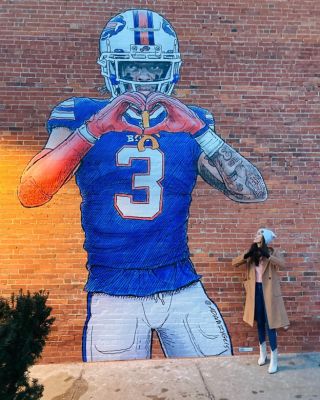Traumatic Brain Injury
Before You Let Your Kids Play Football, Read This
On the fence about football: the positives and the negatives
Posted January 30, 2023 Reviewed by Hara Estroff Marano
Key points
- Parents must balance social and emotional benefits of playing football against the mental and physical costs.
- The longer a player plays the worse the injuries will be.

Physicians and medical practitioners, former football players, concerned parents, historians, sociologists, play advocates, and a couple of college roommates flooded my inbox after I posted an ambivalent rumination about the moral complexities of playing and watching football in the shadow of the near-death injury of Buffalo Bills defensive safety, Damar Hamlin (“Can Football Fans Watch with a Clear Conscience?).
I noted how the game augments strengths such as bravery and fortitude, and self-reliance and solidarity. The game furthers a race-blind meritocracy on the field, and it bolsters the fabric of community. I might have mentioned how football strengthens family ties (and not just between fathers and sons and brothers and brothers) and that football playing and football fandom both provide the occasion for intimacy that society routinely denies young males.
Though football feeds aggression and depends upon it, playing football, undeniably and fortunately, also blows off steam.
On the Debit Side of the Leger
Football entails powerful impact that delivers insults to the human brain, especially concussion, and more insidiously subconcussion. The worst outcomes fall into line on a sliding scale from mood disorder to dementia. Severity correlates with the number of seasons players play. To put it simply, the longer one plays, the worse this gets.
A Boston University study noted that 48 of 53 former college players studied showed signs of chronic traumatic encephalopathy (CTE). Then, decisively, 110 out of 111 NFL players whose brains were examined after death showed the telltale markers of brain injury.
Still, We Love Football
By any measure and in ranking order—among Democrats, Republicans and Independents, women and men, non-white and white, high schoolers through retirees, educational levels from high school to post-graduate—pro football is America’s number one spectator sport.
And it’s no wonder. The game is spectacular. We play vicariously through the spectacle. But players and fans share not just excitement of the contest, but also a moral burden that includes all its heroics and all its recklessness, its generosity and its vehemence, its fierce teamwork and its ferocious competition, and its remarkable skill and athleticism that thrives alongside the unrepentant showmanship and self-aggrandizement. This theatre captivates us.
Some of my correspondents’ observations.
First the Physicians
Stuart Brown, retired surgeon, psychiatrist, avid sportsman who celebrated his 60th birthday by climbing Kilimanjaro, notes that Hamlin’s dreadful on-field experience worked against the “usually deniable or easily minimized” risks. Dr. Brown cites his familiarity with a 45-year-old former NFL player, a “haggard post-encephalopathy” casualty and eventually a suicide. “I share both your enthusiasm and love of the game,” Brown writes, “with the full realization of its widespread morbidity and the moral dilemmas it produces.” Another M.D., Jack Freer, a longtime friend and sports fan, reports how he and an even more fervent colleague once camped out all night for tickets. His dauntless buddy, an emergency room doc, now says he is done with football: “He just couldn’t overlook the brain damage stuff any longer.”
Former Players and Thinkers
Two historians responded, both former players and current fans, and both torn between their regard for the game and the ethical questions that swarm around it. A cultural historian, Jeremy, father of an 8-year-old, endeavors to “put aside [his] rose-colored memories of the game” that “allowed me to do things I couldn’t do anywhere else.” David, the social historian, points to the measures meant to temper the game and make it somewhat safer, especially those that mitigate impact and treat injury—the new helmet technology, rules against head-to-head contact, “the concussion protocol, the blue tent, and a Pro Bowl that is going to be flag football.”
The sociologist Thomas Henricks, an acute observer of play, not quite a fan but securely a “follower,” also observes that, as a “pro-and-con guy,” he acknowledges the ways football builds community, but wonders at the cost.” Football, he writes, “glamorizes a certain type of individual (and mostly keeps females in support/cheerleader roles.)” Ethically, the production of the game “subordinates questions of ends (what should people do collectively) and installs instead questions of means—what should we do to win?” And further, the sport “celebrates an ascetic style of being with its ideas of being tough and playing hurt.” Does the drama of football build character, Tom asks, or does it instead create “characters”?
Injury and Impasse
For perspective, my friend Mike notes that it is not the frequency of injury that is most relevant with football, it is the severity. Of course, all sports come at some cost. Playing baseball is tough on wrists, arms, and shoulders. Basketball grinds knees and ankles. Hockey players endure groin injuries and bad backs. But concussion leads the list of catastrophic lasting injuries for football players.
One million American kids play high school football. The Boston University research cited earlier concluded that three in 14 high school players studied, a bit over 20%, were diagnosed with signs of CTE. The longer players play, the worse it gets. Jeremy has good reason to hope that his son will derive benefits from other sports, competitive soccer, taekwondo, and touch football.
When I asked Monica Ralabate, a busy surgical assistant in neurology, how a high school football player could be reminded of the potential for injury, she acknowledges that they might have chosen differently, but in view of the countervailing hunky glamour of the sport, she concludes, “he won’t listen, and he won’t care… until it happens!” And for emphasis she added, “you can quote me.”
Some professionals seem to be listening, however. David, the social historian, observes that professional players are beginning to weigh the toll the game extracts. And so, balancing the “enormous benefits” against risks, they are retiring earlier and earlier, a few at their peak. The game’s appeal, alongside the “singular and abiding issues” of inherent violence and predictable lifelong injury, however, makes for "the impasse that ends most serious conversations about the spectacle." Noting the allure that generates millions for players and billions for team owners and television networks, he concludes, “we seem destined to deal with the questions you raise, forever.”
References
M.L. Alosco, A.C. McKee, et. al., “Age of First Exposure to Tackle Football and Chronic Traumatic Encephalopathy,” Annals of Neurology, (2018).
Josh Zumbrun, “Severity, Not Frequency, Sets Football Injuries Apart,” Wall Street Journal, (January 13, 2022).




